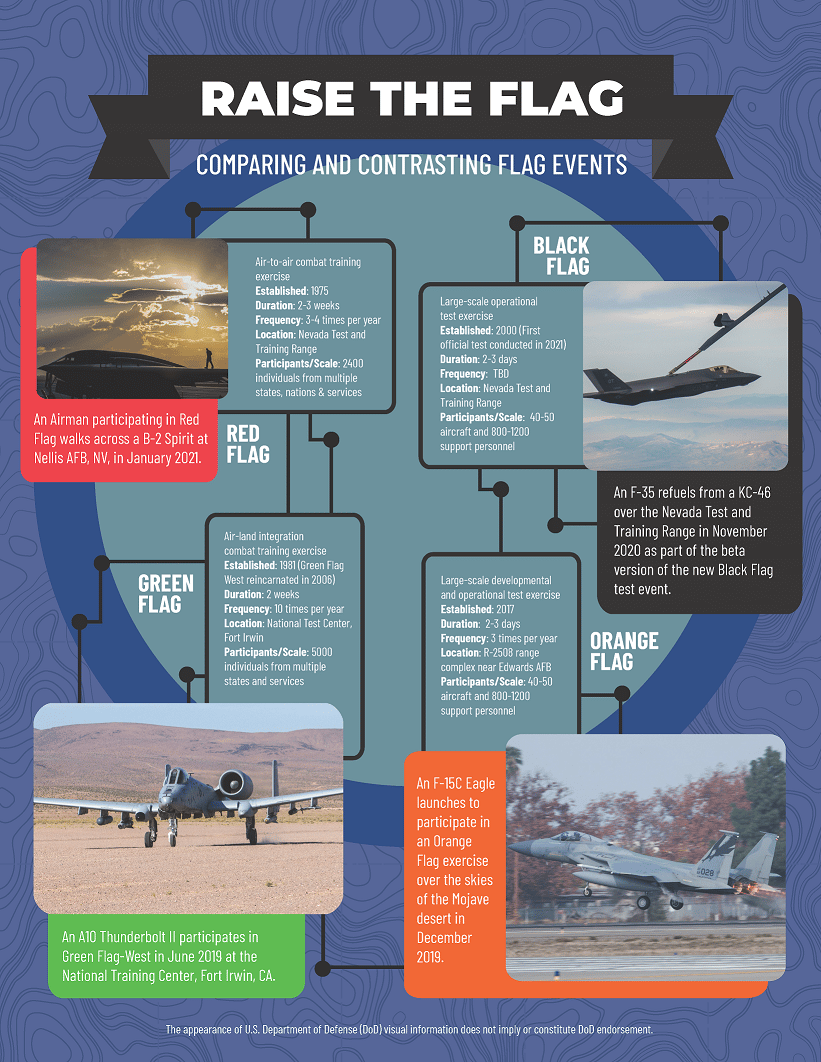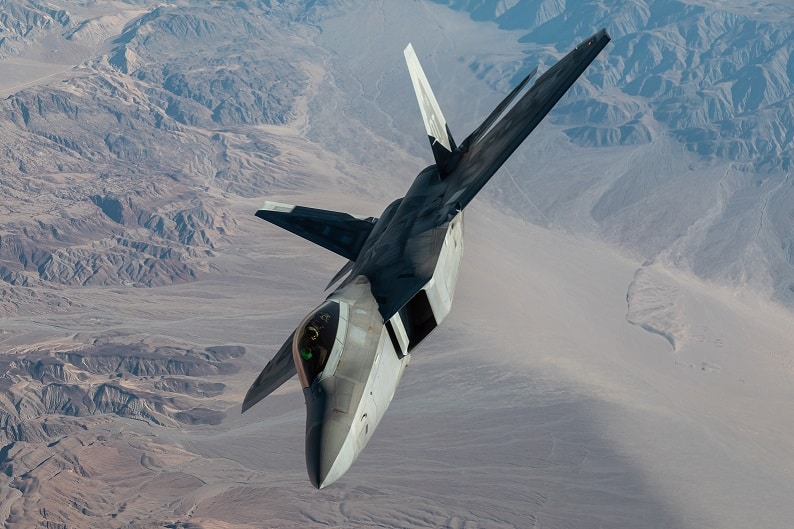A look at the latest and legacy large force exercises supported on the J-Tech II ranges
Train like you fight. That is the concept behind Red Flag, one of the U.S. Air Force’s largest combat training exercises held multiple times a year at the Nevada Test and Training Range (NTTR). Coordinated by Nellis AFB, the exercise involves U.S. and allied forces and a variety of aircraft including attack, fighter, bomber, reconnaissance, electronic warfare, air superiority and aerial refueling aircraft.
Every Red Flag exercise is unique, but the premise is always the same—a “Blue Force” of deployed aircraft and personnel engage in a number of tactics attempting to attack mock airfields, missile sites, vehicle convoys, tanks and various other targets. However, these targets are defended by an enemy “Red Force,” supported by our JT4 employees, who employ electronically simulated anti-aircraft artillery, surface-to-air missiles, electronic jamming equipment and other threats to thwart Blue Force missions and objectives. The result is a rigorous but controlled training environment that provides participating aircrews with the most realistic combat training available.
In December of 2020, the U.S. Air Force Air Combat Command announced a test counterpart to Red Flag—an exercise meant to be to the test world (building capability) what Red Flag is to the training realm (building readiness). Black Flag, the new “test like you fight” event, allows for operational test and tactics development in a realistic, integrated and threat-rich environment.
A typical aircraft will undergo two levels of testing—developmental and operational. Developmental testing, as its name suggests, involves the development of new technologies and systems. However, the often sterilized environment in which such testing occurs is not representative enough to allow for full stress testing and the understanding of those capabilities. Operational testing is used to refine and validate developmental capabilities that can be used to create operational tactics. The Black Flag operational test exercise will allow the U.S. Air Force to push the envelope on new advanced technologies and tactics in an integrated and relevant environment, helping prepare our future Warfighters for the most severe of combat scenarios.
Black Flag formalizes and combines what used to be multiple 1-2 day large force test events (LFTEs). In such events, every aspect of the test is highly specialized and scrutinized. If for any reason the test cannot be executed, millions of dollars in preparation can go to waste. By combining smaller tests into one larger event, it helps guarantee that at least a subset of test objectives are always met. “Another issue is simply NTTR scheduling,” explains Hans Kimm, JT4 Operations Support Manager at NTTR. “The range is just so incredibly busy that if customers miss scheduled tests, their next opportunities may not come up for another five years. So, the ability to combine events is just too attractive to pass up.”
In addition to having overlapping tests, the U.S. Air Force also likes to overlap flag events themselves to further maximize synergy and minimize costs. Red Flag is often held concurrently with Green Flag-West (GFW), an air-land integration combat training exercise conducted in conjunction with the U.S. Navy and Army at the National Training Center in Fort Irwin, California. GFW combines airborne support with forces on the ground to mimic real-world circumstances in a war zone. The exercise provides a robust training experience for airmen, soldiers, Marines and sailors alike who learn how to support each other on the battlefield.
Just as Red Flag goes hand-in-hand with Green Flag, Black Flag has a natural partner in Orange Flag, another test exercise that recently came to fruition. Since 2017, Orange Flag, a large-scale developmental and operational test exercise led by the 412th Test Wing at Edwards AFB, has helped the U.S. Air Force move away from a limited cross-platform and cross-service testing environment to one that is more inclusive and representative of the entire force. By bringing together different parts of both the flight test and flying communities, systems from developmental and operational testing can be improved faster as problems and opportunities with integration and interoperability are uncovered earlier. As a result, new systems may be deployed not only sooner, but in a far more mature state than ever before.
On March 2, 2021, the U.S. Air Force ran its first ever combined Orange and Black Flag event. JT4 employees working at both Edwards, AFB and the NTTR helped support this new and all-encompassing test event that brought test objectives and participants together from across the services into a threat dense, operationally representative environment. While Orange Flag focuses on technical integration, Black Flag concentrates on tactical integration. However, since they both require the same threat-representative environment, the U.S. Air Force can achieve both desired test objectives at minimal cost by combining resources.
The success of combined exercises like the joint Orange Flag-Black Flag event this spring suggests we can expect to see more collaborative efforts from our customers in the future. Red, Green, Orange or Black, JT4 employees will continue to provide the highest levels of technical support for all large scale test and training flag-level events conducted on the J-Tech II ranges.
What’s in a name?
Across the enterprise, JT4 employees support hundreds of test and training missions for our customers every year, many of them being large force employment (LFE) or large force test events (LFTEs). What makes such an event worthy of a flag-level name? Historically, a red flag used by a military force was an indication that it was preparing for battle, thus making “Red Flag” the perfect name for the U.S. Air Force’s simulated combat training exercise. Other flag-level events have a similar magnitude in terms of the amount of resources, level of integration and the number of aircraft involved in the exercise. The color associated with the event often has some kind of significance. For instance, orange is the traditional color for the flight testing community and is a highly appropriate choice for a test event focused on developmental and operational testing. Flag exercises originated after the Vietnam War era and were intended to simulate the high stress and operational tempo of the first 10 combat sorties for American warriors prior to entering actual combat. This is because historically, the overwhelming majority of combat losses occur in those first 10 missions. For almost 50 years, combat aviators have attested to the incredible value of flag exercises in enhancing their effectiveness and survivability during those first crucial combat sorties. This is why flag exercises will continue to be a critical part of maintaining a combat-ready force.


